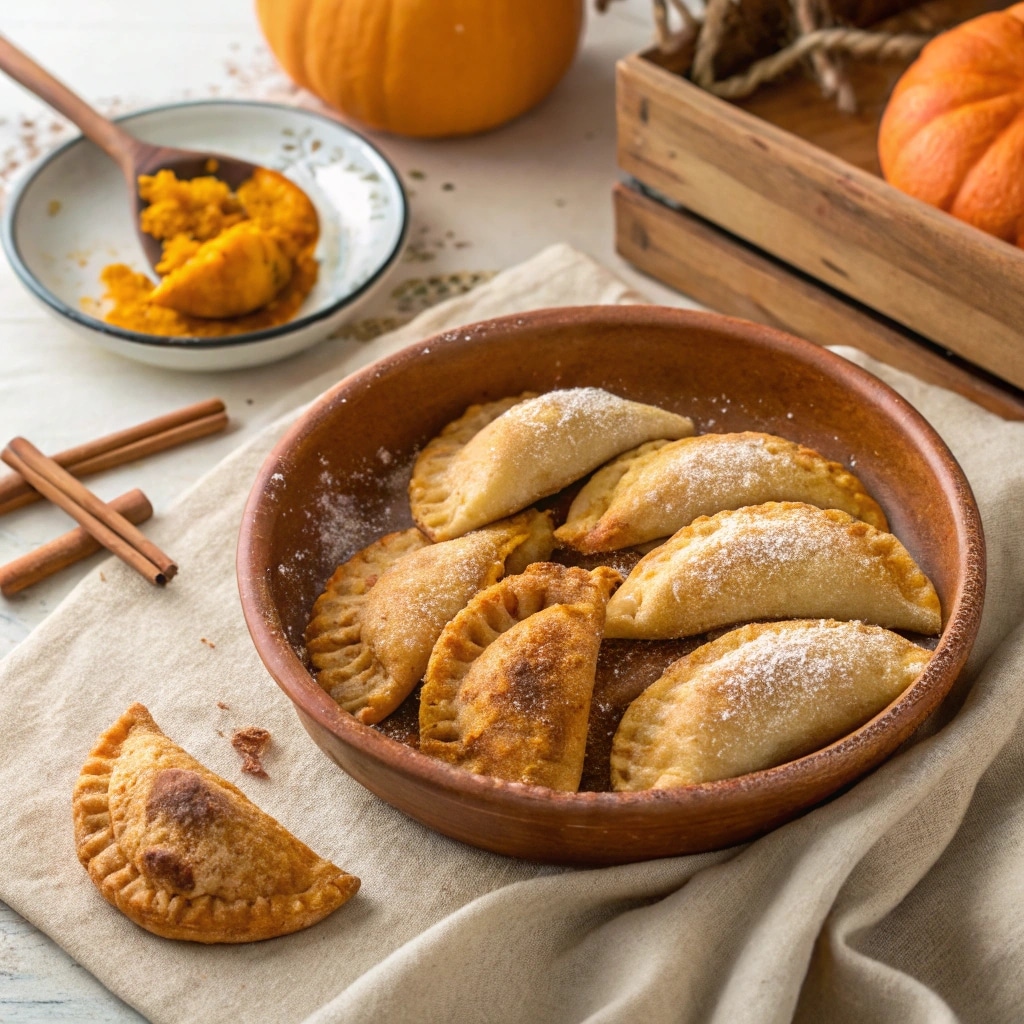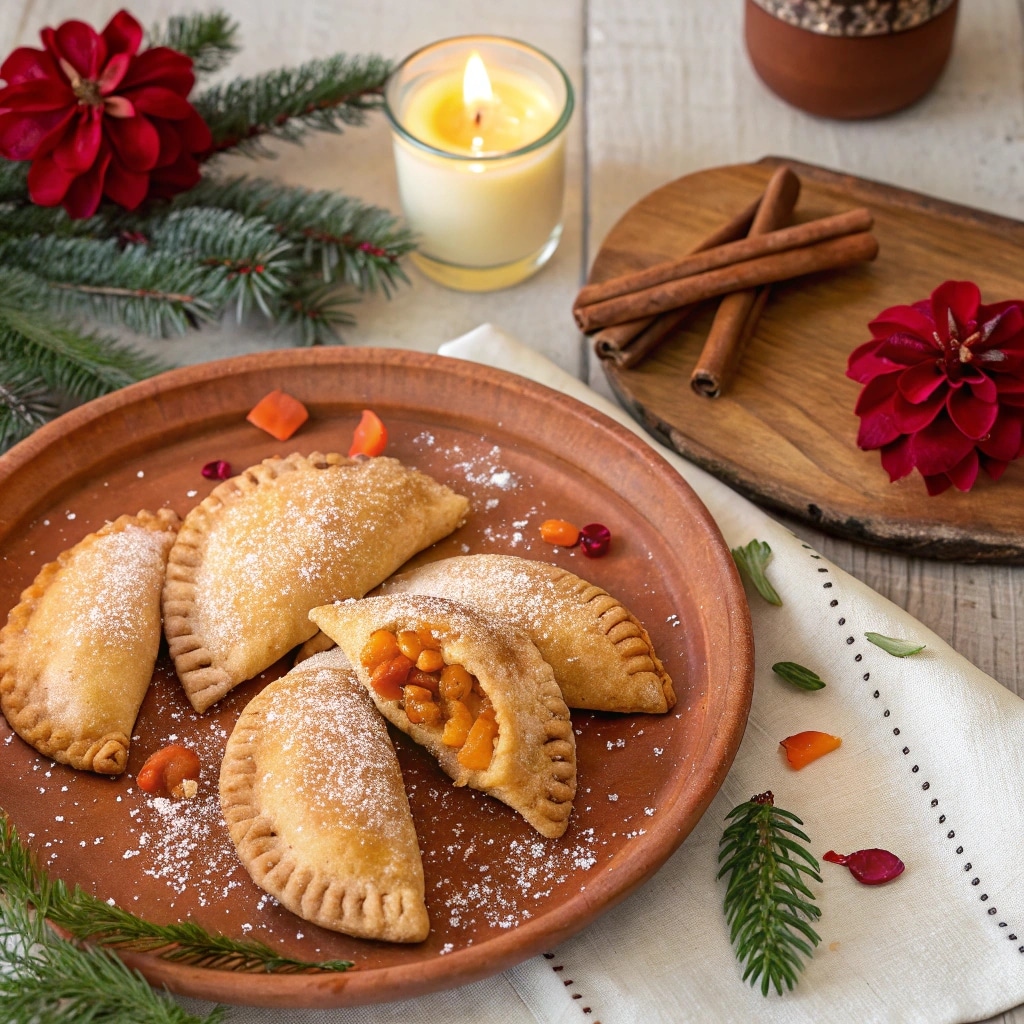My earliest memories of autumn in Santa Fe are tied to the sweet scent of cinnamon, pumpkin, and sugar wafting through our home. Every year, as leaves turned golden outside, I’d find my Grandma Carmen at the kitchen table, hands dusted with flour, patiently teaching me how to fold empanadas. Grandma Carmen, originally from Michoacán, Mexico, is the heart of our multigenerational home. She often says that her empanadas de dulce (sweet empanadas) carry our family history in each bite. With a warm smile, she recalls how her own mother taught her to crimp the edges of the pastry just so – in a fluted, pleated pattern – creating beautiful little dumpling-like pies filled with love and dulce.
Growing up, I didn’t realize our family tradition was part of something much bigger. To me, it was simply weekend afternoons of storytelling and baking: Grandma recounting her girlhood in Michoacán as we pinched the empanada dough into tiny pleats. We’d gossip about family and laugh, all while the dough circles became half-moons stuffed with spiced pumpkin or gooey caramel (cajeta). The way we sealed those empanadas always fascinated me. Instead of using a fork to press the edges, Grandma Carmen showed me how to fold and pinch them into a ruffled border. It’s a skill that felt so special – almost like folding an Asian dumpling – and it gave each empanada a pretty, crimped braid. That little decorative twist wasn’t just for looks; it symbolized the care and technique passed down through generations (and ensured none of the precious filling leaked out!).
Origins of a Sweet Tradition
Grandma often reminds me that empanadas weren’t originally Mexican, but they found a true home in Mexico. Historically, the idea of a pastry wrapped around a filling came from the Spanish colonists who arrived in the 1500s. (In fact, the very word empanada comes from the Spanish empanar, meaning “to wrap in bread.) The Spaniards had been enjoying empanadas – likely thanks to influences from the Moors and even ideas borrowed from other cultures’ stuffed pastries – and they brought these hand pies to the New World. According to Grandma (and, later on, my own research), the Spanish invaders shared their empanada recipe with the Aztecs and Maya when they settled in Mexico. But there was a twist: the Old World recipe used wheat-based bread dough, while the indigenous cooks ingeniously used corn masa to make their empanada shells. This adaptation made sense; corn was abundant and sacred in Mesoamerica, so the earliest Mexican empanadas were more like a cousin to today’s corn tortillas than the flaky pastries we know now.
What really surprised me was learning that those early Mexican empanadas were often sweet rather than savory. In fact, before empanadas became localized to each region of Mexico, an “empanada” meant a deep-fried corn masa turnover filled with sweet pumpkin or sweet potato. Imagine that – the very first empanadas enjoyed in Mexico were treats made with New World ingredients, satisfying the sweet tooth of our ancestors. Over time, of course, regional cuisines put their own stamp on empanadas. Some areas stuck with corn masa and frying, making empanadas that resemble what you’d find sold by street vendors (filled with meats, beans or cheese, almost like a stuffed gordita), for more information en.wikipedia.org. Other regions, especially those influenced by colonial bakeries, embraced wheat flour dough and baking in clay ovens, creating the golden-brown crusted empanadas we see in Mexican panaderías (bakeries). Each region of Mexico adapted the empanada to its local ingredients and tastes, so there’s no single “right” way to make one – and that’s the beauty of it.
Despite these savory variations, Mexico is especially known for its sweet empanadas today. In many Latin American countries, empanadas are thought of mainly as savory meat-filled hand pies. But here, sweet empanadas have become a beloved part of our dessert and coffee culture. You’ll find them proudly displayed in bakery windows, usually in the mornings or late afternoons, ready to be enjoyed with a cup of coffee or hot chocolate. My grandma likes to say an empanada can brighten your breakfast or make the perfect late-afternoon merienda (snack) – and she’s right. Whether filled with fruit or caramel, these sweet half-moons are a staple at Mexican gatherings and holidays, just as much as they are everyday treats.
Dumpling-Style Folding: The Art of the Empanada
One of the most charming aspects of our empanadas – and the reason I call them “dumpling-style” – is the way we fold them. Many cultures have their version of a filled dumpling or turnover, and our Mexican empanadas are part of that global family. As a little girl, I was mesmerized watching Grandma Carmen’s fingers at work. She would place the filling in the center of a dough circle, fold it into a half-moon, and then do something magical: pinch, twist, pinch, twist, all along the edge. In no time, she’d crafted a perfect tiny braid along the seam of the pastry. “Así, m’ija – like this, my daughter,” she would say, guiding my hands to crimp the edge tightly. She took pride in those elegant pleats, and I came to understand it was more than just aesthetics.
Folding an empanada with care serves both form and function. The pleated or rope-like edge (known as a repulgue in Spanish pastry lingo) locks in the tasty filling and keeps the empanada from opening as it bakes or fries. But just as importantly, it’s a signature of love and craftsmanship. In some countries like Argentina, the pattern of the folds even signals what filling is inside – each repulgue design might indicate beef, chicken, or corn, for example. In Mexico, we may not have an official code for fold patterns, but every family – every baker – often has their own habitual style. My grandma’s empanadas, for instance, have tight, ridged pleats that remind me of the dumplings I’d later see at a Chinese restaurant, whereas others simply crimp with a fork for a dotted edge. Whenever I make these at home now, I channel her technique. I pinch and flute the edge just like she taught me, feeling a connection to generations of cooks who sealed their pastries with the same timeless motion.
It’s funny to think how universal this method is. The idea of wrapping dough around a delicious filling and decorating the edge with pinches or folds appears in so many cultures. We have empanadas and tamales with twisted ends; the Chinese have potstickers with pleated skirts; the Indians have half-moon samosas sealed tight; Eastern Europeans have their crimped pierogi. It’s as if, all around the world, grandmothers knew that a little pinch of finesse would keep our favorite foods safely tucked inside their doughy blankets. In our family, those pretty empanada edges are a little flourish that says “someone cared enough to make this by hand.” I carry on that tradition proudly, knowing that every time I pleat an empanada, I’m recreating an art passed down through centuries.

Sweet Fillings and Regional Flavors
Of course, an empanada is only as good as its filling, and Mexico’s sweet empanadas have a rich variety of fillings that reflect our local fruits, harvests, and cravings. The fillings are where regional traditions really shine. In Grandma Carmen’s home state of Michoacán, for example, bakers along the coastal towns are famous for their creative sweet empanadas. She often recalls how, in her youth, you could find huge 8-inch empanadas sold by the roadside, hot from wood-fired clay ovens, filled with whatever was in season. On the costa michoacana, they might use fresh coconut, mashed sweet potato, pineapple with cinnamon, or even creamy rice pudding as fillings. If you ever traveled there and didn’t taste one of their famous empanadas de coco or camote, she jokes, it was like you never visited at all! In central Mexico, other traditional fillings abound: markets and bakeries offer empanadas oozing with pumpkin spiced with cinnamon, sweetened mashed beans (yes, sweet black bean paste – it’s better than it sounds), or jams made from guava, pineapple, or apple.
Some of the most beloved sweet fillings across Mexico include:
- Pumpkin (calabaza) – Autumn brings empanadas de calabaza, using pumpkin cooked down with brown sugar or piloncillo (unrefined cane sugar) and cinnamon. These treats are like hand-held pumpkin pies, often enjoyed around Día de Muertos (Day of the Dead) or Thanksgiving time for those of us straddling cultures. Their warm spiced filling and sugary crust make them a fall favorite.
- Cajeta (Goat’s Milk Caramel) – Perhaps the crown jewel of Mexican empanadas. Cajeta is a silky, rich caramel made from goat’s milk, a tradition born out of necessity when colonial Mexico had more goats than cows. Empanadas de cajeta are intensely sweet and often sprinkled with sugar on top. This filling became popular because goat’s milk caramel has a wonderfully complex flavor – slightly nutty, not just one-note sweets. (Fun fact: cajeta got its name from the little wooden boxes, cajas, in which the caramel was once stored.) Many Mexican bakeries carry cajeta empanadas, and they’re a must-try for any caramel lover.
- Guava and Cream Cheese – Tropical guava (guayaba) paste tucked inside a tender pastry is a Cuban and Puerto Rican favorite, but Mexico loves it too. Often, a dab of cream cheese is added to create that irresistible sweet-tangy combination (similar to a guava y queso pastry). In coastal parts of Mexico and the Yucatán, guava or other tropical fruit empanadas are common, sometimes enjoyed at breakfast with coffee.
- Sweet Potato (camote) – Empanadas de camote are filled with mashed sweet potato that’s been cooked with sugar, cinnamon, and maybe a hint of orange or vanilla. They’re especially popular in some central regions. In Guadalajara, for instance, sweet potato empanadas (or pineapple ones) have even become part of Easter tradition – locals enjoy them during Holy Week as a symbol of life’s sweetness and the hope of the season. It’s common to see both sweet and savory empanadas made for the Easter holiday, sometimes dusted in sugar as a special treat.
- Pineapple (piña) – A bright, jammy pineapple filling is another bakery standby. Empanadas de piña are usually made with a homemade pineapple jam (flavored with a bit of clove or cinnamon) and often dyed a golden yellow. In some places like the Pacific coast, you might even find pineapple mixed with shredded coconut inside an empanada for a tropical twist. They taste like sunshine in a pastry pocket!
A batch of golden-brown sweet empanadas (here filled with pumpkin and cajeta) fresh from the oven. Each one is hand-crimped along the edges, giving it that dumpling-style look with braided pleats.
Every family might have a slightly different recipe for the dough, too. In our family, the empanada pastry is a soft wheat-based dough enriched with a bit of butter, and a hint of cinnamon. Some cooks add a splash of milk or even orange juice to the dough for extra flavor. The result is a crust that’s tender and a little flaky, but sturdy enough to hold the filling. Traditional Mexican empanada dough tends to be lightly sweet (just a couple of tablespoons of sugar in the mix) – it’s not as rich as pie crust, but not as lean as bread. Once filled and folded, many bakers will sprinkle sugar or cinnamon-sugar on top of the empanadas before baking, which creates a lovely sweet crust. Grandma Carmen always brushes ours with a bit of milk and then dips them in a plate of sugar, so when they bake, they develop a delicate sugary shell that crackles with each bite. It’s heavenly.
It’s worth noting that while we mostly bake our sweet empanadas, frying is also common in some areas or for certain fillings. A fried empanada with a sweet filling is an indulgence – imagine a crispy exterior giving way to molten pumpkin or caramel inside. ¡Qué rico! But for day-to-day baking, especially when making big batches for family, the oven is our best friend.
From Heritage to Modern Table
As much as I cherish the old ways, I’m also amazed at how empanadas continue to evolve. These dumpling-style sweet empanadas have journeyed from colonial kitchens to humble village ovens, and now all the way to trendy American cafes and fusion restaurants. What was once a treat you’d only find in Mexican abuelitas’ homes or local panaderías is now gaining fame worldwide. In fact, cajeta empanadas and other traditional flavors are making their way onto upscale restaurant menus in the U.S., touted as authentic Latin American desserts. It’s heartwarming to see a new generation discovering these pastries – sometimes with a modern spin.
Here in the Southwest, I’ve started to see creative takes on empanadas at food festivals and holiday markets. People experiment with sizes and presentations: mini bite-sized empanadas for cocktail parties, or decorative empanadas molded into shapes (I once saw skull-shaped empanadas for Día de Los Muertos – talk about a creative twist!). The fillings are also becoming a playground for innovation. Nutella and chocolate hazelnut empanadas? Yes, those exist now. Apple pie empanadas drizzled with caramel – a nod to American apple pie. Some ambitious home cooks even deep-fry their empanadas and then toss them in cinnamon sugar to mimic churros. As empanadas enter the “Pinterest era,” it seems anything that can be wrapped in dough and called an empanada has been tried – from Oreo-stuffed dessert empanadas to gourmet combinations of fruits and nuts.
Yet, even with all the modern creativity, the heart of the empanada remains the same. It’s still that comforting idea of family and tradition wrapped in dough. I feel it every time I host a gathering. For birthdays, Thanksgiving, or Christmas, I’ll often bake a big batch of empanadas to share. My American friends love the unique dessert, and my Hispanic relatives get that nostalgic gleam in their eye when they take a bite. Grandma Carmen couldn’t be prouder that I’m continuing her legacy. She’ll tell anyone who’ll listen that her granddaughter makes empanadas just like she taught her – well, almost as good! And truth be told, at every family party, it’s Grandma’s empanadas (the ones she still makes herself, with me as her assistant) that disappear first from the dessert table.
We also keep alive the holiday associations that empanadas have accrued over the years. For instance, during Easter, we always include empanadas de camote or piña in our spread, an homage to the Guadalajara tradition where the sweet filling represents the “sweetness of life” during the holy season. At Christmas, I make empanadas de cajeta y nuez (caramel and pecan) because something about the rich caramel feels festive and indulgent, perfect for winter. And in the fall leading to Día de Muertos and Thanksgiving, it’s pumpkin empanadas all the way. These occasions just wouldn’t feel complete without these pastries making an appearance. As one Mexican student aptly said in an article I read, empanadas are made, sold, and served at gatherings and holidays – they’ve become a staple of celebration. In our household, that is undeniably true.
Looking at the journey of our dumpling-style Mexican empanadas, I’m filled with gratitude. This simple pastry has carried centuries of history – from the influence of Spanish colonists and Middle Eastern samosas to the hands of Indigenous cooks who made it their own, and finally to my grandmother who taught me with so much patience and love. It amazes me that something as humble as an empanada can tell the story of cultural fusion and family tradition. With each pleat we fold and each sweet bite we take, we are tasting history.
As I continue to bake these empanadas in my Santa Fe kitchen, I imagine my Grandma Carmen as a young girl learning the same technique from her mother back in Michoacán. I feel connected to that lineage. And I also feel excited about the future – knowing that one day I’ll teach someone (maybe my own children) the same dumpling-style folds, share the same stories, and watch their eyes light up with the same joy I had. In a world full of new desserts and fleeting food fads, our empanadas remain a comforting constant, bridging past and present. They remind us that the sweetest traditions, much like family recipes, are meant to be savored and passed on.
¡Buen provecho! And may you, too, get to enjoy a warm Mexican empanada – dumpling pleats and all – with your family, creating memories that last a lifetime.

